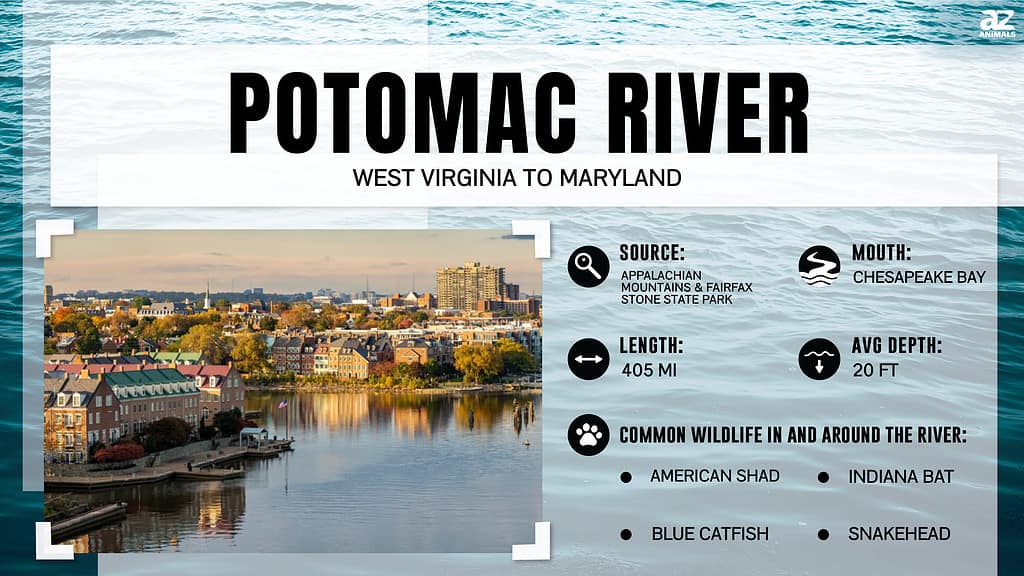
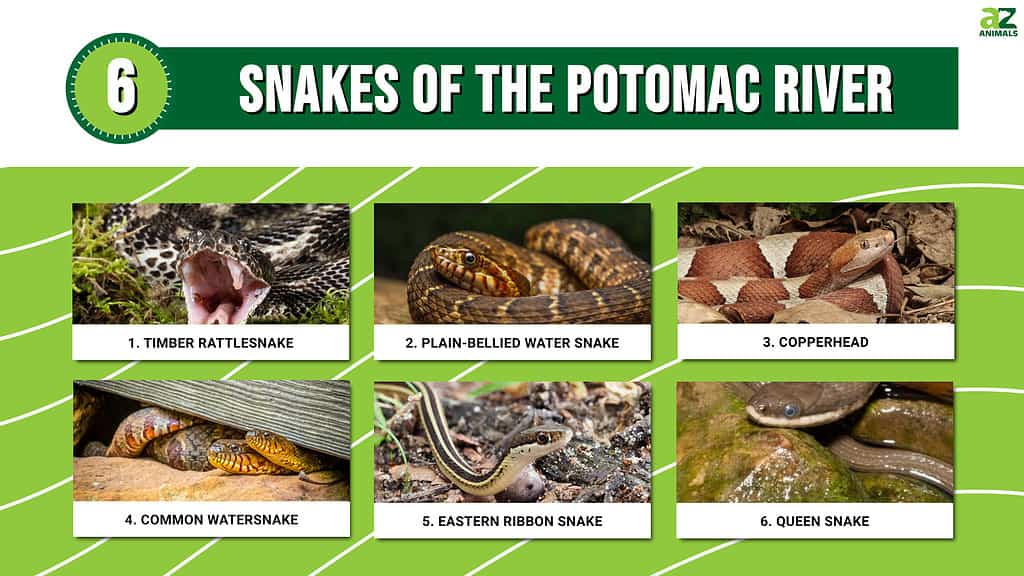
The Potomac River, which flows just about 400 miles, is one of the most historically important rivers in the United States. Its waters straddle the states of Virginia, West Virginia, Maryland, and Washington D.C. There are many snakes in the Potomac River, only a few of which pose any danger to humans. Other than snakes, the waters of the Potomac abound with fish and amphibians and provide vital resources for all manner of creatures, including white-tailed deer, raccoons, opossums, and even humans.
Here, we’ll learn about six snakes of the Potomac River. We’ll discover where they live, what they look like, and whether or not their scaly mouths contain venom. By the end, you’ll know a little bit more about some of the snakes that call this East Coast river their home.
1. Timber Rattlesnake
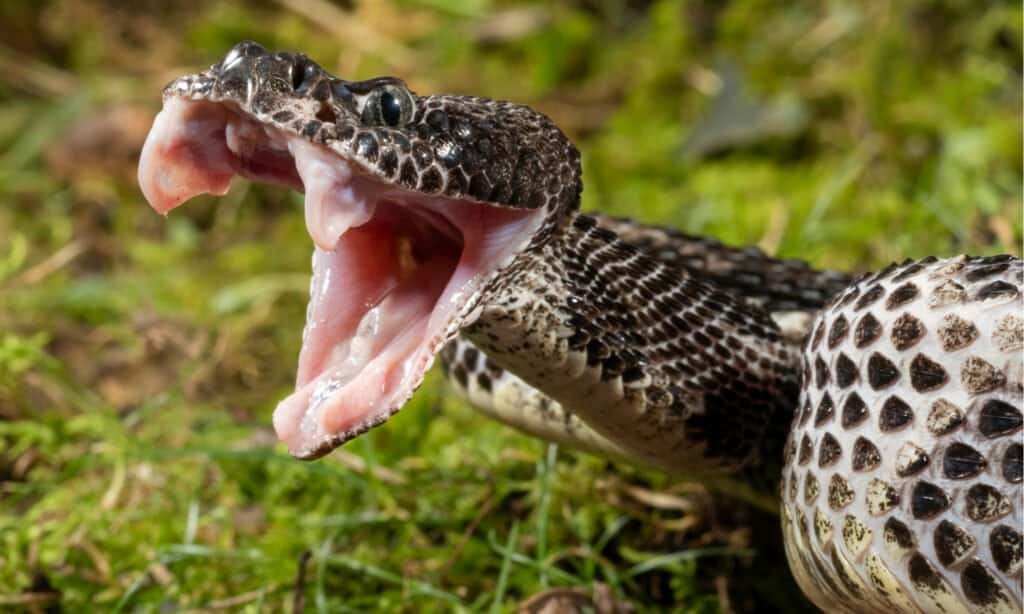
Timber rattlesnakes have potent neurotoxic venom.
©Joe McDonald/Shutterstock.com
Timber rattlesnakes are among the deadliest snakes of the Potomac River. These pit vipers grow up to five feet long, and they have heavy bodies that terminate in conspicuous rattles. Their base color is tan or light brown, with darker, hexagonal bands striping their bodies from head to tail. Like all rattlesnakes, these snakes have wide, triangular heads complete with heat-sensing pits, vertically elliptical eyes (like cat eyes), large fangs, and venom glands.
Timber rattlesnakes have potent neurotoxic venom; any bite from one of these snakes requires immediate medical attention. These snakes use their venom to hunt other snakes, birds, frogs, rats, moles, mice, and other small mammals. They spend their days basking in the sun and their winters brumating in abandoned rodent burrows.
2. Plain-bellied Water Snake
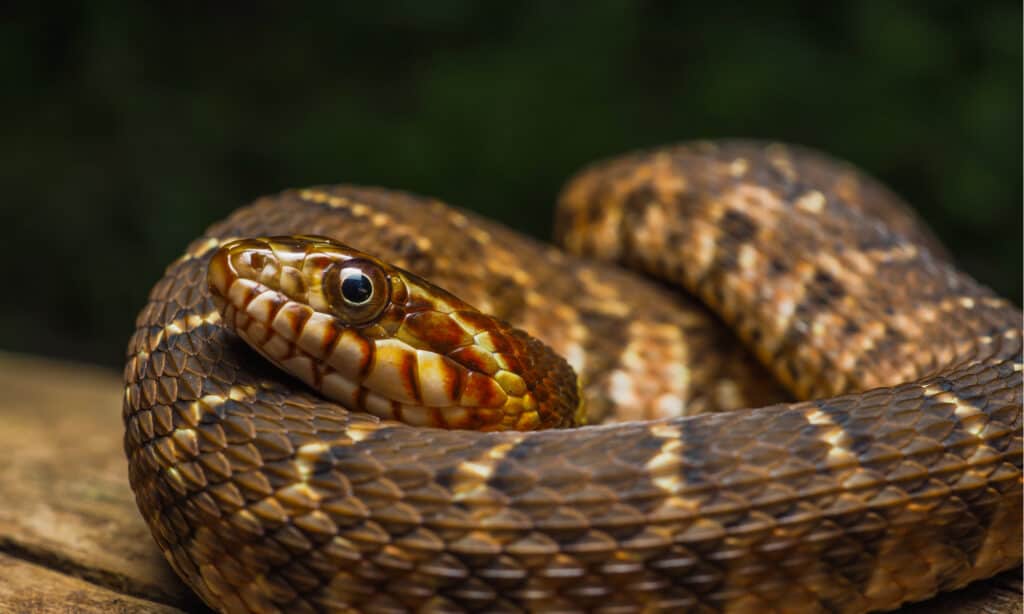
Plain-bellied water snakes primarily hunt in the water.
©Tyler Albertson/Shutterstock.com
Plain-bellied water snakes of the Potomac River have thick bodies and grow up to 3.5 feet long. As their name suggests, their bellies are pale in color and lack any markings. Their sides and backs are generally dark brown-gray with some indistinct blotches. These snakes lack venom and spend most of their time either in or near sources of fresh water, including the Potomac itself.
Plain-bellied water snakes primarily hunt in the water. Their favorite prey items include frogs, toads, salamanders, tadpoles, crayfish, and small fish. They rely on constriction to kill their prey and may hunt both during the day and at night. Since they have no venom, these snakes are not considered dangerous to humans.
3. Copperhead

Copperheads eat everything from spiders and scorpions to small mammals, lizards, and snakes.
©Creeping Things/Shutterstock.com
Copperheads are among the most easily recognized snakes of the Potomac River. They have heavy bodies and grow up to three feet long. Though they bear a superficial resemblance to rattlesnakes, copperheads are the only snakes with their unique hourglass pattern. They’re typically orange-brown, with copper-colored heads and darker hourglass markings along their bodies. These snakes also have vertically elliptical eyes, pointed snouts, and leaf-shaped heads.
Copperheads are habitat generalists who prey on a wide range of creatures. They eat everything from spiders and scorpions to small mammals, lizards, and snakes. They’re often encountered by humans but only bite in self-defense. Though copperhead bites rarely lead to serious complications, they still warrant immediate medical attention.
4. Common Watersnake

Common watersnakes are non-venomous and pose no threat to humans.
©samray/Shutterstock.com
As their name suggests, common watersnakes are among the most prevalent snakes in the Potomac River. They grow up to 4.5 feet long and have slender bodies designed for life in the water. They’re generally light tan or gray-brown in color, with indistinct darker bands and blotches. Unfortunately, these snakes are often mistaken for venomous cottonmouths and killed by fearful humans. They have narrow heads and round pupils, unlike their more dangerous cousins.
Common watersnakes are non-venomous and pose no threat to humans. They hunt mostly fish and amphibians, and they never stray too far from permanent sources of fresh water.
5. Eastern Ribbon Snake

Given their small size, eastern ribbon snakes are restricted to relatively small prey.
©Steve Bower/Shutterstock.com
Eastern ribbon snakes of the Potomac River are among several subspecies of ribbon snakes. They grow up to three feet long and have very thin bodies. These snakes are easily recognizable by the alternating dark gray-black and pale yellow stripes that run from their heads to their tails.
Given their small size, eastern ribbon snakes are restricted to relatively small prey. These include small fish, frogs, tadpoles, insects, and salamanders. They lack venom and rely instead on ambush, attacking their prey in and near the water.
6. Queen Snake
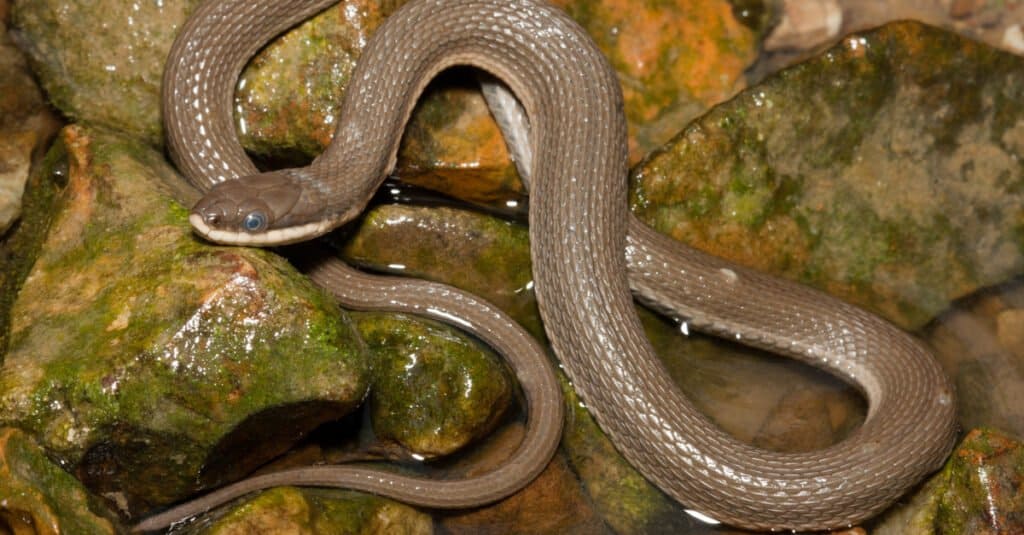
Queen snakes live near permanent sources of freshwater and eat mainly crayfish.
©Nathan A Shepard/Shutterstock.com
Like ribbon snakes, queen snakes of the Potomac River are semiaquatic. They grow up to two feet long and have slightly thicker bodies than those of ribbon snakes. However, like ribbon snakes, queen snakes have alternating dark and light stripes running the length of their bodies. These snakes are nonvenomous and have round pupils and long, narrow heads adapted for catching one species in particular.
Queen snakes live near permanent sources of freshwater and eat mainly crayfish. They also eat frogs, snails, tadpoles, and newts. These snakes are not venomous and pose no threat to humans. If attacked, they may release musk or repeatedly bite in self-defense.
Summary Of 6 Snakes Of The Potomac River
| # | Snake | Venomous or Non-Venomous |
|---|---|---|
| 1 | Timber Rattlesnake | Venomous |
| 2 | Plain-bellied Water Snake | Non-venomous |
| 3 | Copperhead | Venomous |
| 4 | Common Watersnake | Non-venomous |
| 5 | Eastern Ribbon Snake | Non-venomous |
| 6 | Queen Snake | Non-venomous |
Other Reptiles Found In The Potomac River
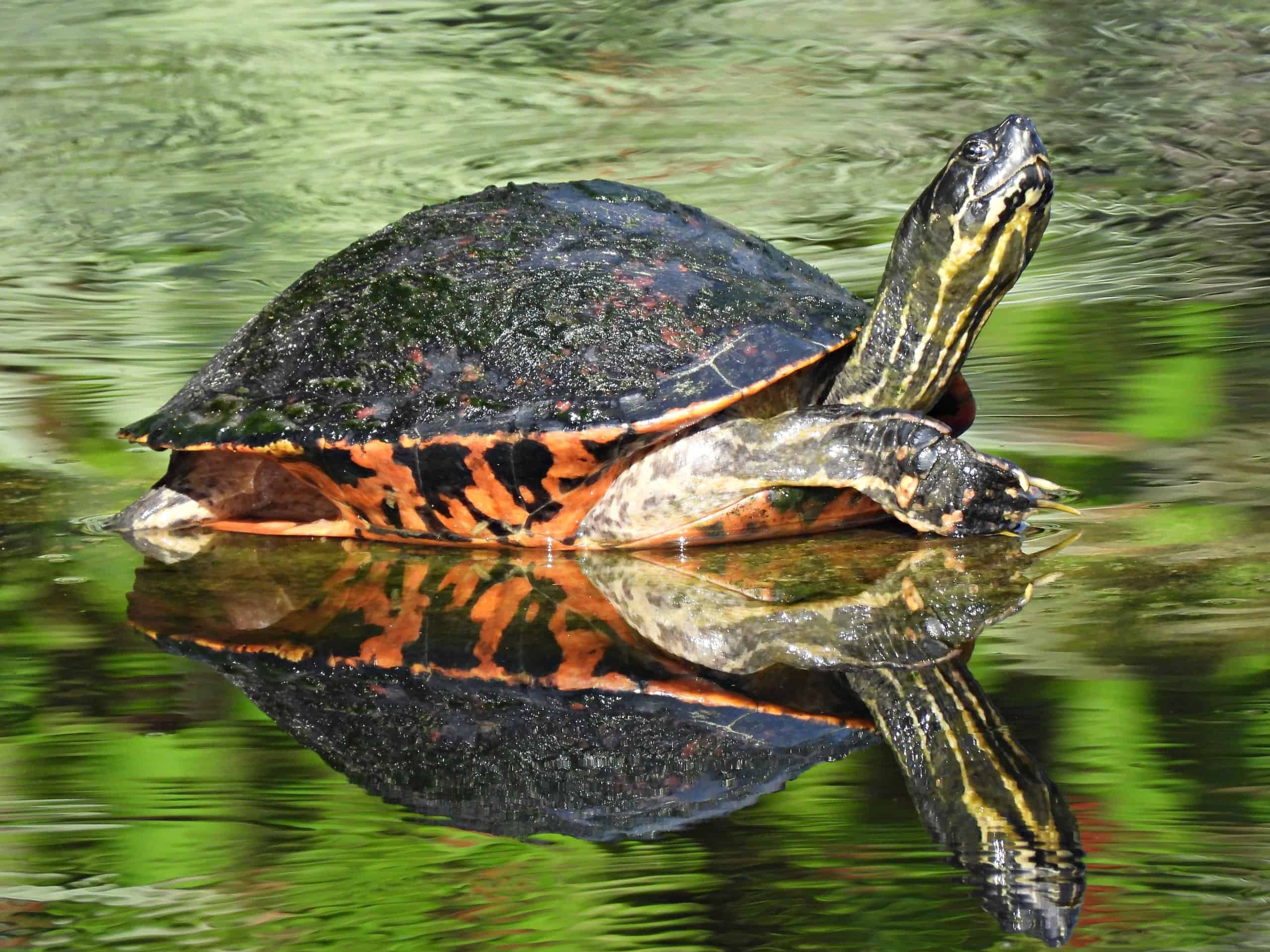
Red-bellied Cooter is a native species found throughout the Potomac area.
©iStock.com/passion4nature
The red-bellied cooter, also known as the redbelly turtle, is an aquatic turtle that is usually found basking at the edge of rivers, streams, and ponds all over the Potomac River. This native species can grow anywhere from 10 to 12.5 inches and has a highly domed shell that can range in colors from black to brown with red bands across the middle, which may sometimes only appear when wet. It gets its name from the underside, or belly, which is reddish in color. This omnivore has a lifespan of between 40 to 55 years and is often confused with painted turtles but is larger, being the largest turtle in the area, and is very reserved and should be left alone.
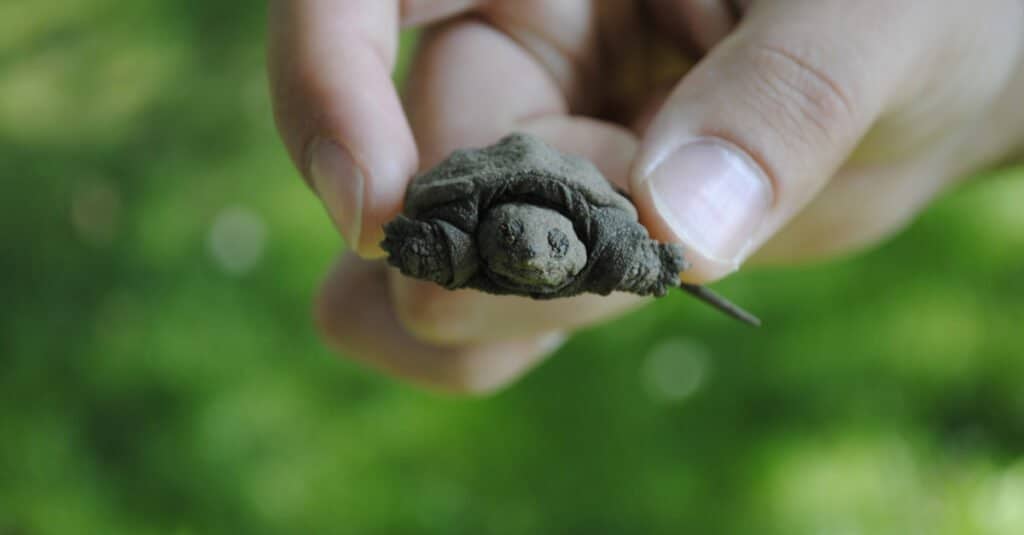
Baby
snapping turtles
start out small but will grow to between 8 to 20 inches.
©JessKay/Shutterstock.com
The extremely aggressive snapping turtle can be found throughout the Potomac River and it won’t hesitate to snap at any attackers, which are primarily humans as they have few predators. This almost entirely aquatic reptile can grow to lengths between 8 to 20 inches and weigh from 10 to 35 pounds with bulky limbs and flat brown shells that are usually covered with algae. While these turtles may appear harmless, especially when they are young, they still have a strong bite that can cause serious injuries and are even capable of amputation. You should always proceed with caution when seeing a snapping turtle.
The photo featured at the top of this post is © Tim Malek/Shutterstock.com
Discover the "Monster" Snake 5X Bigger than an Anaconda
Every day A-Z Animals sends out some of the most incredible facts in the world from our free newsletter. Want to discover the 10 most beautiful snakes in the world, a "snake island" where you're never more than 3 feet from danger, or a "monster" snake 5X larger than an anaconda? Then sign up right now and you'll start receiving our daily newsletter absolutely free.
Thank you for reading! Have some feedback for us? Contact the AZ Animals editorial team.






